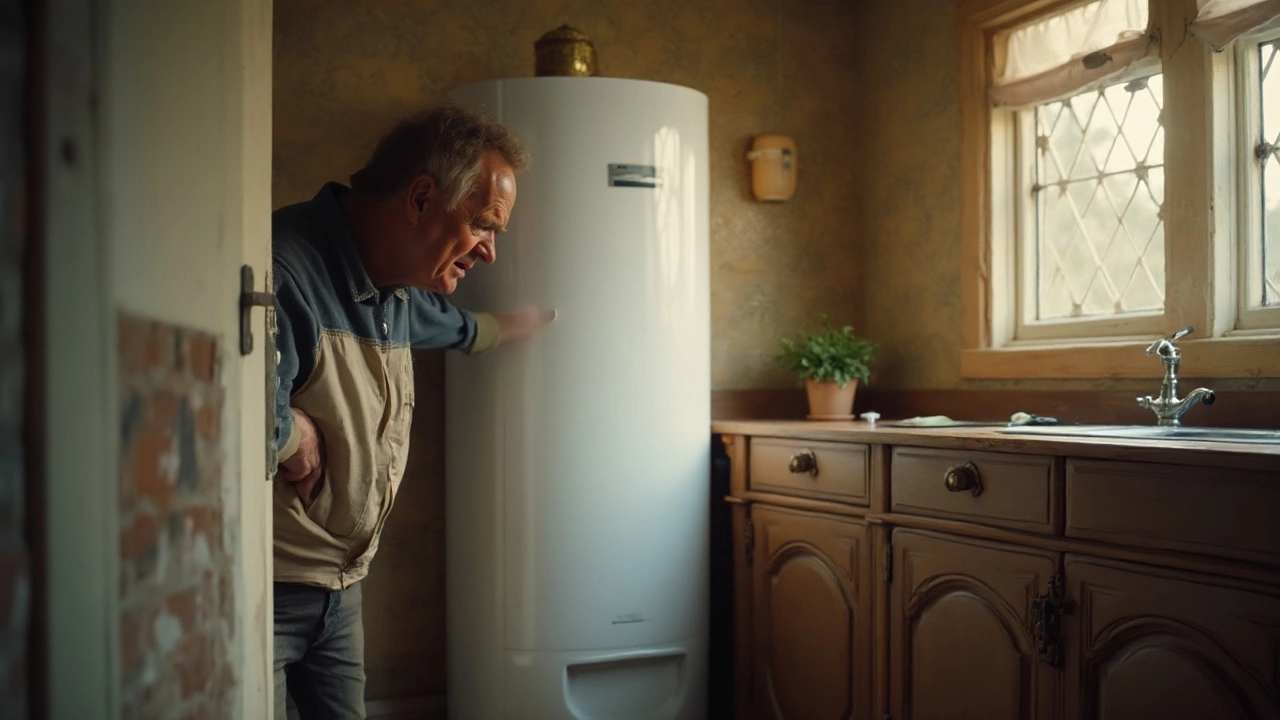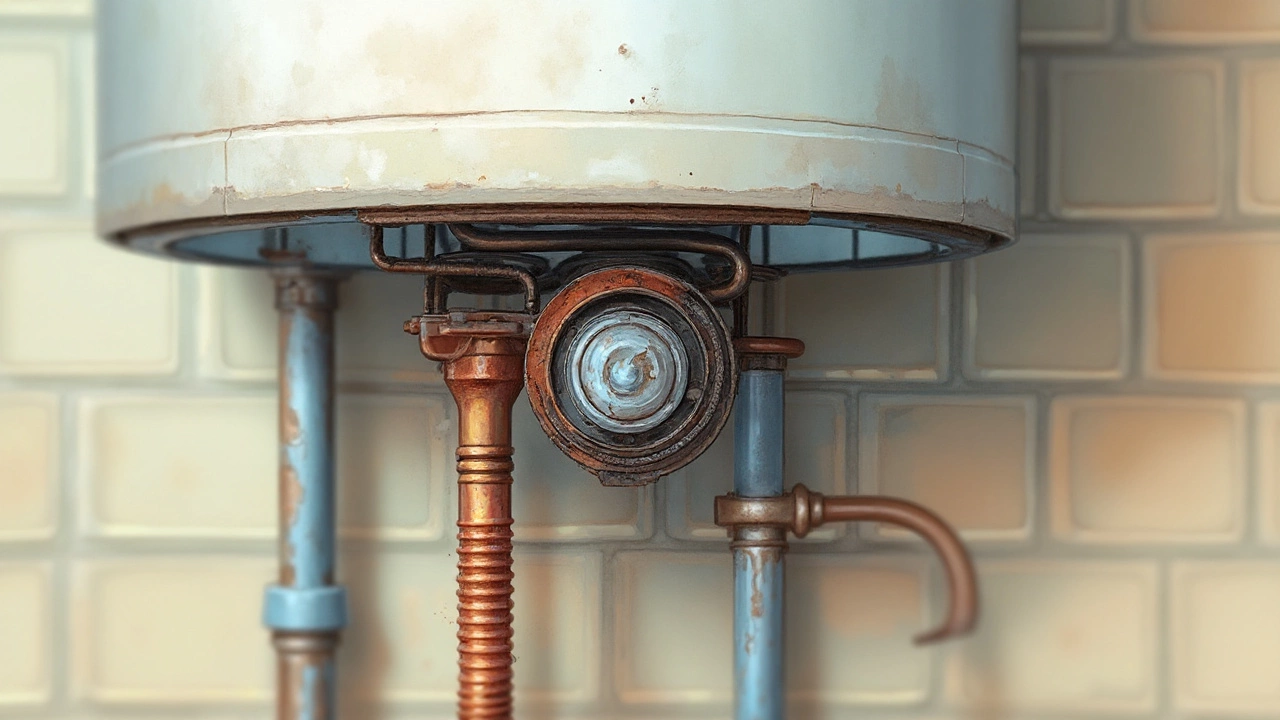Signs Your Hot Water Heater Element Is Bad: Troubleshooting and Repair Tips
 Aug, 8 2025
Aug, 8 2025
Bad hot water heater element—there’s a phrase nobody’s happy to hear. Imagine this: you get up on a freezing Toronto morning, drag yourself to the shower, and... icy water hits your back. Not exactly the motivational start you wanted. Sometimes, the culprit hiding behind your misery isn’t an empty tank or a broken thermostat—it’s a faulty heater element. I’ve had my share of wrestling with old water heaters in my own home, so believe me, you can often sniff it out faster than you’d think if you know the right clues.
Common Warning Signs of a Failing Water Heater Element
Hot water running out way too fast or not getting hot at all? That’s suspect number one. A bad element often means your tank’s just not heating as it should. You might notice lukewarm water where there once was steam, and that's often because water’s only partially heated—usually when half the element’s burned out. Some heaters have two elements (top and bottom for the vertically-challenged tanks), and if one croaks, you’re not fully out of hot water, but it’s like driving with one tire half flat.
If Cedric complains that his bath turns cold halfway through, or my wife can't finish a load of dishes because the kitchen sink’s as cold as Lake Ontario in January—yep, that’s classic failing element territory. Here are a few specific signs to spot when you think your water heater might have an internal issue:
- Reduced hot water volume: You get hot water for a minute, but the tank runs out abnormally quick.
- Lukewarm water: If your “hot” tap isn’t coming near scalding even when cranked up, that hints the element isn’t firing right.
- Cold water only: Both elements can sometimes fizzle out, leaving you with just a glorified cold water tank.
- Water is too hot: Rare, but if a thermostat is working with a defective element, sometimes you get scalding water.
- Popping or hissing sounds: Element caked with mineral buildup can make quirky noises as water sizzles against the scale.
- Visible corrosion or leaks: Windows into the tank aren’t always possible, but check for suspicious leaks or corrosion near the element.
Sometimes the symptoms are subtle. For instance, Rusty, my never-wrong mutt, even noticed he couldn’t get his usual warm bath and started circling the bathroom, looking annoyed. Mother Nature’s not making your water cold—your element might be.
Why Do Water Heater Elements Fail?
Now, if your element’s on the fritz, you want to know why. The roots usually don’t have anything to do with bad luck. Toronto’s got serious hard water—just look at the leftover streaks on your shower glass. Every time your heater fires up, minerals like calcium and magnesium start clinging to the element, forming a crusty layer called “scale.” That scale ends up trapping heat, and the element runs hotter than it should until...poof. Out.
Other culprits? Sometimes your heater’s just getting old. Most elements are rated for 6–10 years, but if you haven’t flushed your tank or changed the anode rod in years, it might not last that long. Anode rods help fight internal corrosion, and it’s wild how they save your heater’s insides. But if they dissolve away and you don’t replace them, the element and the tank start rusting out.
Thermostat issues also come into play. If your thermostat sticks or fails, your element can run longer than needed, wearing it out fast. And in really rare cases, electrical surges or wiring faults fry the element. Lightning, faulty installation, or old wiring can add to the damage, but it’s mostly buildup and wear-and-tear.
One study from the Canadian Appliance Energy Centre tracked water heaters in homes like mine and found that in hard water areas, almost half needed a new element in less than seven years. They also found that tenants who regularly flushed their tanks had far fewer element issues—so, skip the annual flush, and you’re just asking for trouble. If you never hear your heater’s relief valve hiss, you’re due for some quick maintenance checks.

Testing Your Water Heater Element: DIY or Call in the Pros?
Testing a heater element isn’t rocket science, but don’t wing it without a plan. They operate at dangerous voltages—240 volts in most Canadian homes—so if you’re going to poke around, switch off the breaker first. I can’t say this enough: make sure the power is off at the electrical panel, not just at the wall.
Let’s break down the steps like you’re teaching Cedric to tie shoelaces, not launch a space shuttle. Here’s how you check the element yourself:
- Flip the breaker for the water heater. Double-check there’s no power with a non-contact voltage tester—even the pros get surprised sometimes.
- Remove the access cover for the upper and lower elements (if you have both). You’ll need a Phillips screwdriver—nothing fancy here.
- Peel back the insulation and the plastic protective cover.
- Carefully disconnect the two wires on the element.
- Get your trusty multimeter and set it to ohms (Ω) for resistance testing.
- Touch the probes to each terminal on the element. No reading? The element’s dead. A good element usually reads between 10-20 ohms, depending on wattage. If you get a zero or infinity, it’s time for a new one.
- Also check for a short by placing one probe on a terminal and one on the metal tank—if you read anything but infinity, the element’s grounded and shot.
Sounds like a hassle, but it’s usually a 10-minute job once you gather your tools. If you’re not comfortable, or if your multimeter gives you a reading that makes you scratch your head, no shame in calling a licensed electrician or plumber. I messed up my first test by forgetting to switch my multimeter off “DC volts”—don’t be me.
Water heater elements are cheap. Replacing one is usually less than an hour’s work, and there are loads of how-to videos online. Just remember to refill and bleed air out of the tank before flipping the breaker back on, or you risk dry-firing the new element. Trust me, doing it right the first time saves you grief later.
Pro Tips to Prevent Heater Element Trouble—and When to Replace
Want to keep your water heater healthy and avoid the ice-bucket surprise? Routine maintenance is the name of the game. Flushing your tank every spring can sweep away chunks of scale and grit, especially if your neighbourhood’s water is as mineral-rich as Toronto’s. Replacing the anode rod every 3–5 years keeps rust at bay and helps the element last longer. Pick up a cheap sacrificial rod at the hardware store—it’s worth its weight in gold.
Check your thermostat settings too. Setting the temp over 55°C (130°F) bumps up scale and energy bills without really giving hotter water. At the same time, cranking it up is how some people try to “force” hotter water—but that just cooks your element faster. A reasonable 49–54°C (120–130°F) does the trick for most homes without risking burns or scaling.
If you consistently run out of hot water or see heavy mineral debris in your tub, don’t ignore it. That’s your tank screaming for help. Doing nothing could mean replacing the entire water heater, which isn’t exactly pocket change—think upwards of $1,000 for installation in Toronto, even for basic tanks.
When to replace? If you’ve replaced the element once and it fails again quickly, or if you see visible rust, water pooling at the base, or persistent breaker trips, your tank may be reaching retirement. Old-age heaters (10+ years) are ticking time bombs. Sometimes, a new tank is safer and more efficient. Modern models are insulated better and heat faster, so it’s not all doom and gloom.
Before you tear into the heater, check your warranty. Some tanks carry 6–12 year coverage on elements, so keep your papers handy. Cedric once “filed” our warranty between his Harry Potter books—don’t ask. If all else fails, get a pro to quote repairs versus a new tank, especially if you’ve got a complex gas or hybrid model.
To wrap it up, knowing when and how to spot a bad element saves hassle and icy showers. Do a little maintenance, get familiar with basic tests, and keep a close eye on those first hints of trouble. A warm, steamy shower in the middle of winter? Worth every bit of effort, trust me.
